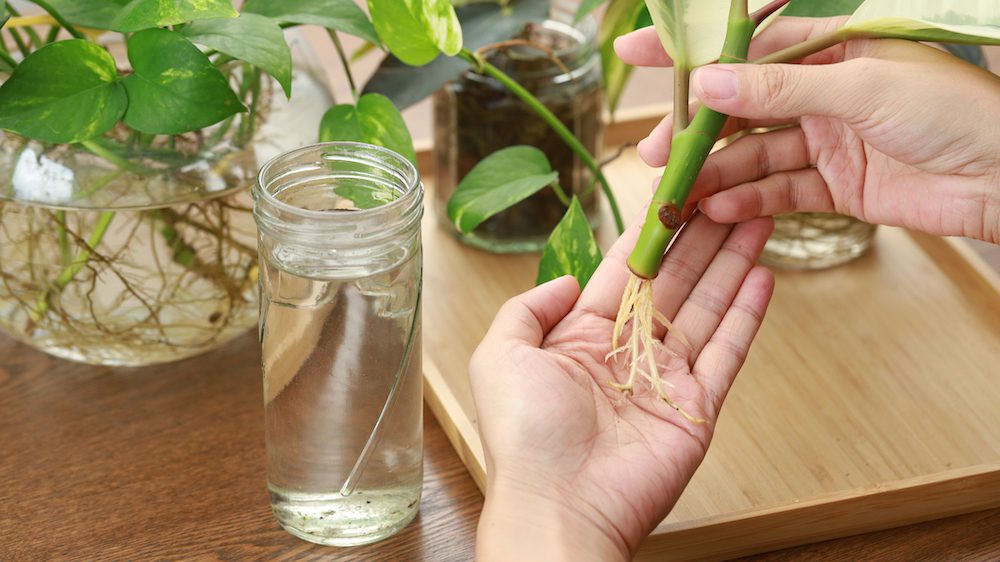
Getty Images
If you enjoy gardening and want to get more out of the plants you have, you may want to turn to plant propagation to expand your garden.
“Propagating plants is an inexpensive and easy way to reproduce plants,” says Angelo Randaci, the master gardener and horticulture expert at Sarasota Green Group. “You can propagate plants that you already have but want more of, or plants that are hard to find. It is one of the most rewarding aspects of gardening.”
Ahead, your primer on plant propagation, direct from the gardening experts.
Best plants to propagate
“Many common houseplants like pothos, ZZ plant, or Christmas cactus are easy to propagate from cuttings,” says Aaron Lynn-Vogel, the horticulture answer service coordinator for the Missouri Botanical Garden. “There are also several landscaping plants, like roses, hydrangea, and culinary herbs that can be easily grown from cuttings. Some specific plants are particularly difficult to propagate, but if you’re willing to set your mind to it, you can propagate just about anything via cuttings.”
Amy Enfield, horticulturist for Miracle-Gro and Bonnie Plants, says the easiest plants to propagate for beginners are mostly herbaceous, non-woody plants. She suggests starting by propagating houseplants, herbs, or succulents.
“Pothos can be easily propagated in either water or soil, and produces a nodule or node at each leaf that will form into a root,” says Enfield. “For succulents like burro’s tail and jellybean succulent, you just need a leaf to grow a new plant.”
Enfield says soft-stemmed herbs like basil, mint, oregano, and lemon balm can be rooted in water.
Tools for propagation

Getty Images
Propagation is pretty straightforward, but you will need a few supplies to get started.
“Fortunately, root cutting is very low-tech. All you need is a sharp knife or pruners to cut the roots, and some potting mix to plant them in,” says Lynn-Vogel. “Many professionals prefer a knife over scissors, because of the [scissors’] potential to crush delicate root ends instead of slicing cleanly.”
In addition to those tools, Randaci suggests having a garden fork or spade for digging plants out of the ground and a well-draining soil mix. He says a 1:1 mix of perlite or sand and a quality potting soil will work.
When to propagate plants
“Root cuttings are typically taken in late winter or early spring, while the plant is still dormant,” says Randaci. “Because roots contain high levels of carbohydrates before they begin spring growth, chances are better for success.”
Taking root cuttings in the winter or early spring minimizes the stress to the parent plant, according to Lynn-Vogel. Plus, since most of us are recuperating during the cold months, it’s also a great time to focus on your plants.
1. How to propagate plants in water

Getty Images
To root in water, Enfield says to choose a stem on your plant that is healthy and actively growing. Make a slightly angled cut, about 2 to 4 inches down the stem, just below a node.
Remove any leaves from the bottom of the cuttings that will be in the water. Then, put your cutting in a clear glass, fill with room-temperature water to cover the bottom inch or so, and change the water every two to three days. In a few weeks, roots should form at the nodes along the stem.
“Once the roots are a few inches long, transplant your cutting into a container with potting mix,” says Enfield.
2. Propagating plants in soil
To root in soil, first dig around the outside of the parent plant to expose its root system and carefully excavate the soil from around the roots.
“Small plants can be completely lifted out of the ground, but with larger plants, it is generally easiest to just expose one side,” says Lynn-Vogel. “Look for roots that are light in color, fleshy, and roughly the thickness of a pencil.”
Next, take root cuttings 2 to 6 inches long, making sure to take longer roots for plants with thinner roots. Be sure to avoid taking more than a third of the parent plant’s roots, in order to keep it alive, and replant it immediately after taking the cuttings. Lynn-Vogel says root cuttings can be planted horizontally or vertically.
In a pot filled with well-draining potting mix, he says, make a small hole the depth of the cut root and insert the root. You want to plant it in the same direction as it was originally growing—so the thinner end should be at the bottom, and the thicker end, which is where it was cut from the plant, is at the top. Gently fill in the hole so that the cut root end is just below the soil surface, about a half-inch deep.
If a seed tray flat is used, make shallow trenches about 1 inch deep, and then lay root cuttings horizontally in the trenches, making sure to cover them with soil so the proximal end is just below the surface.
“The vertical method works best for shrubs and other thick-rooted plants, and the horizontal method is best for perennials and thin-rooted species,” says Lynn-Vogel.
He recommends placing them in a semiprotected location that remains cool for the remainder of winter. It’s important to keep the mix moist, but not constantly soggy with overwatering.
The post Plant Propagation From Cuttings: 2 Ways To Grow Your Garden for Free appeared first on Real Estate News & Insights | realtor.com®.
No comments:
Post a Comment